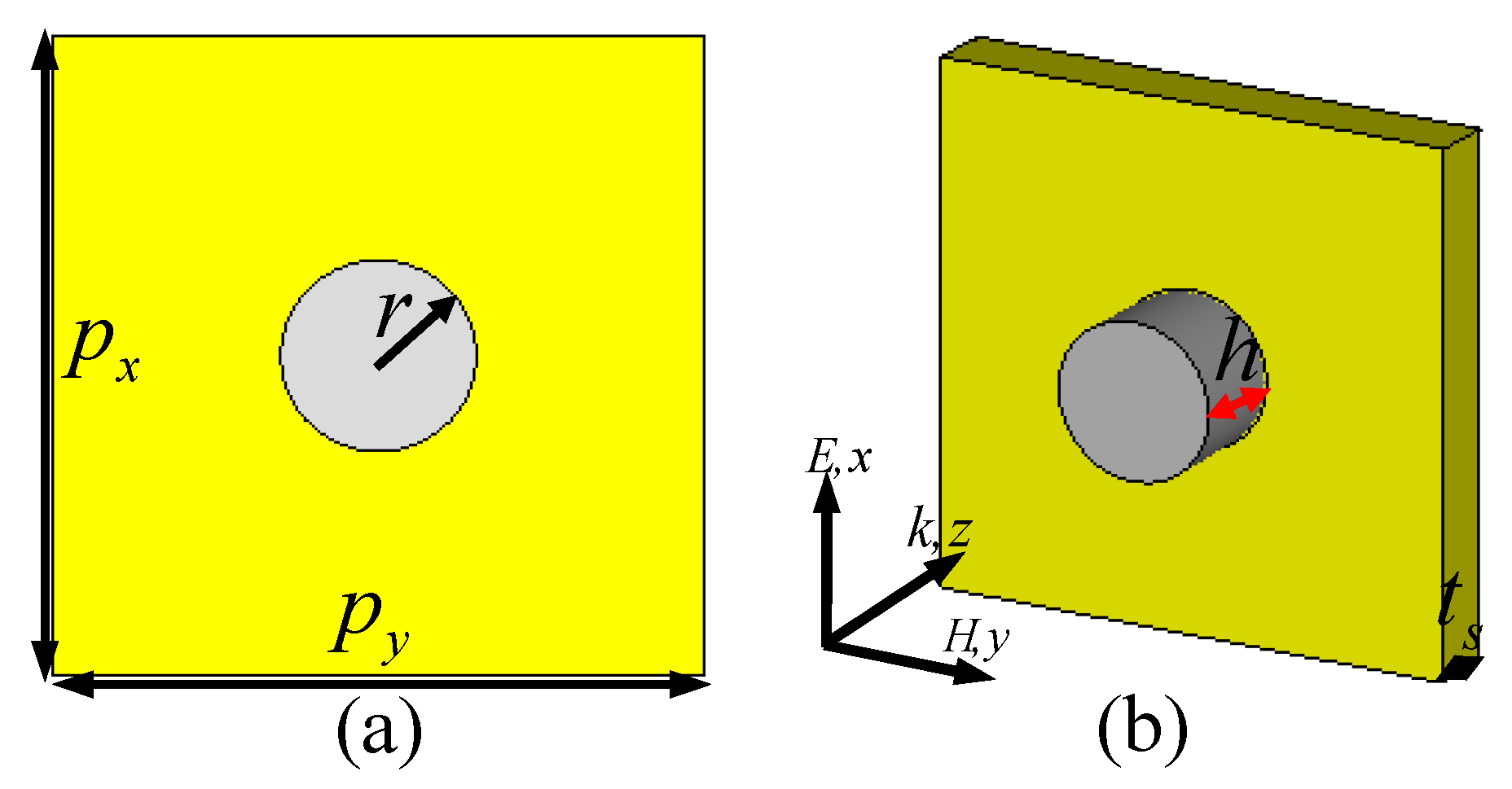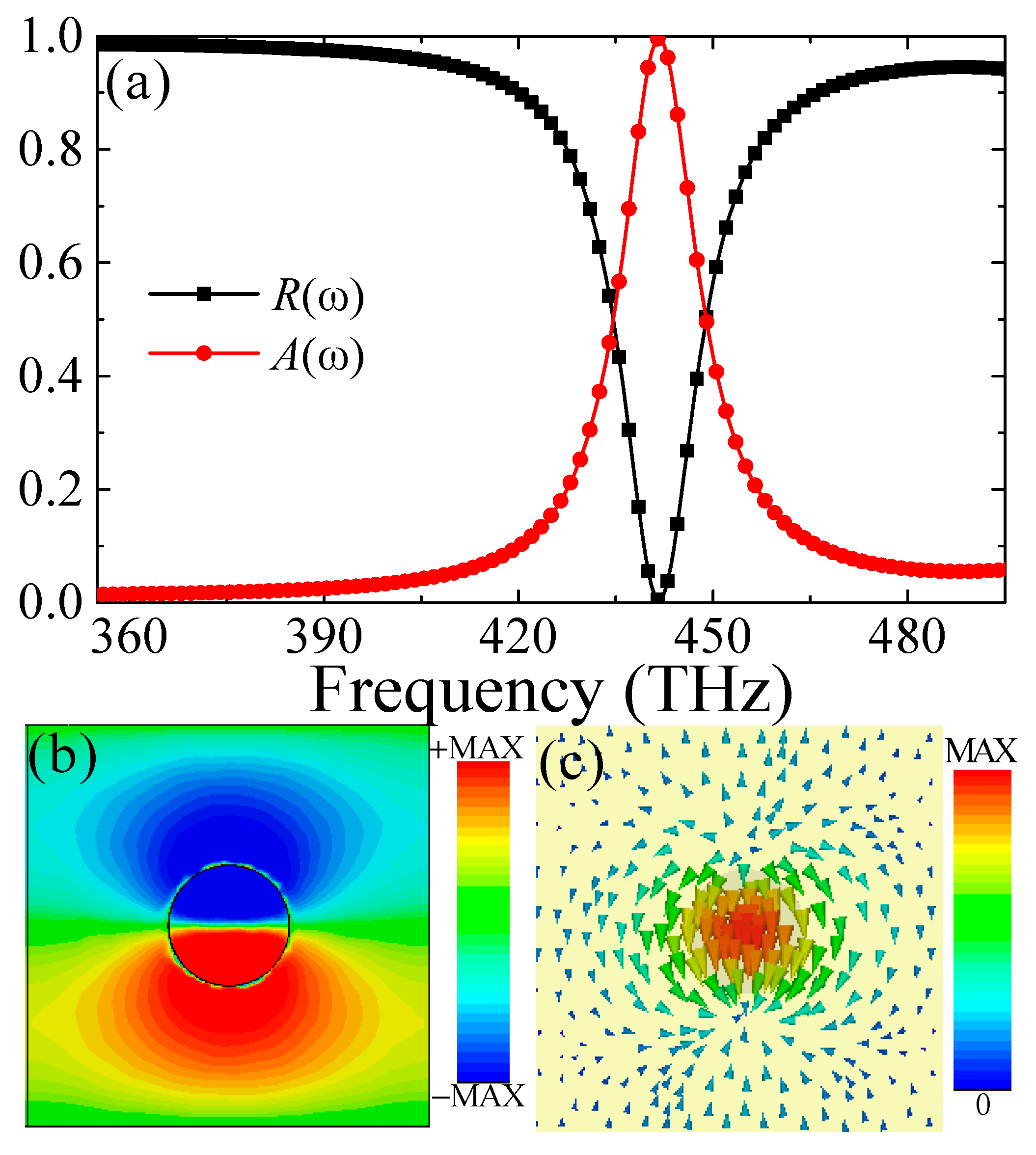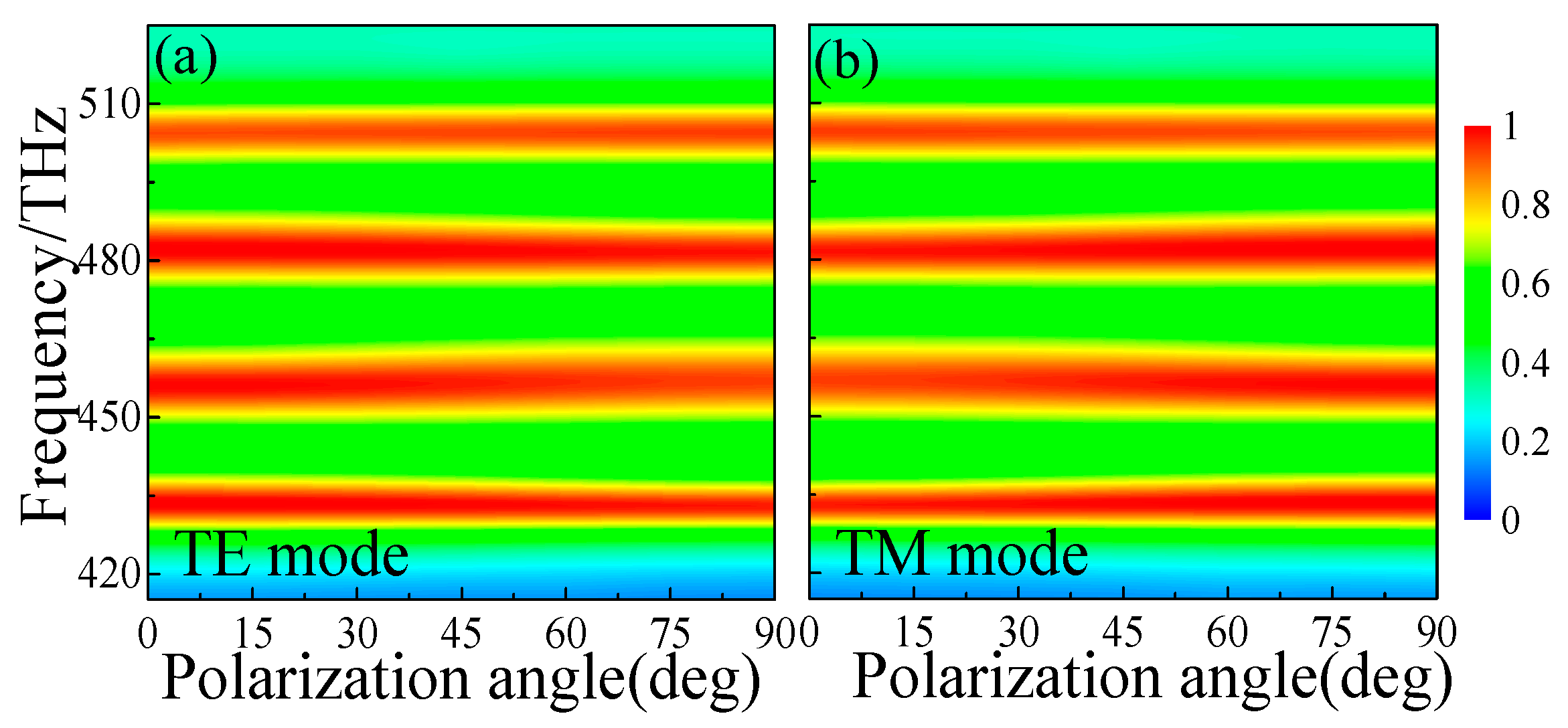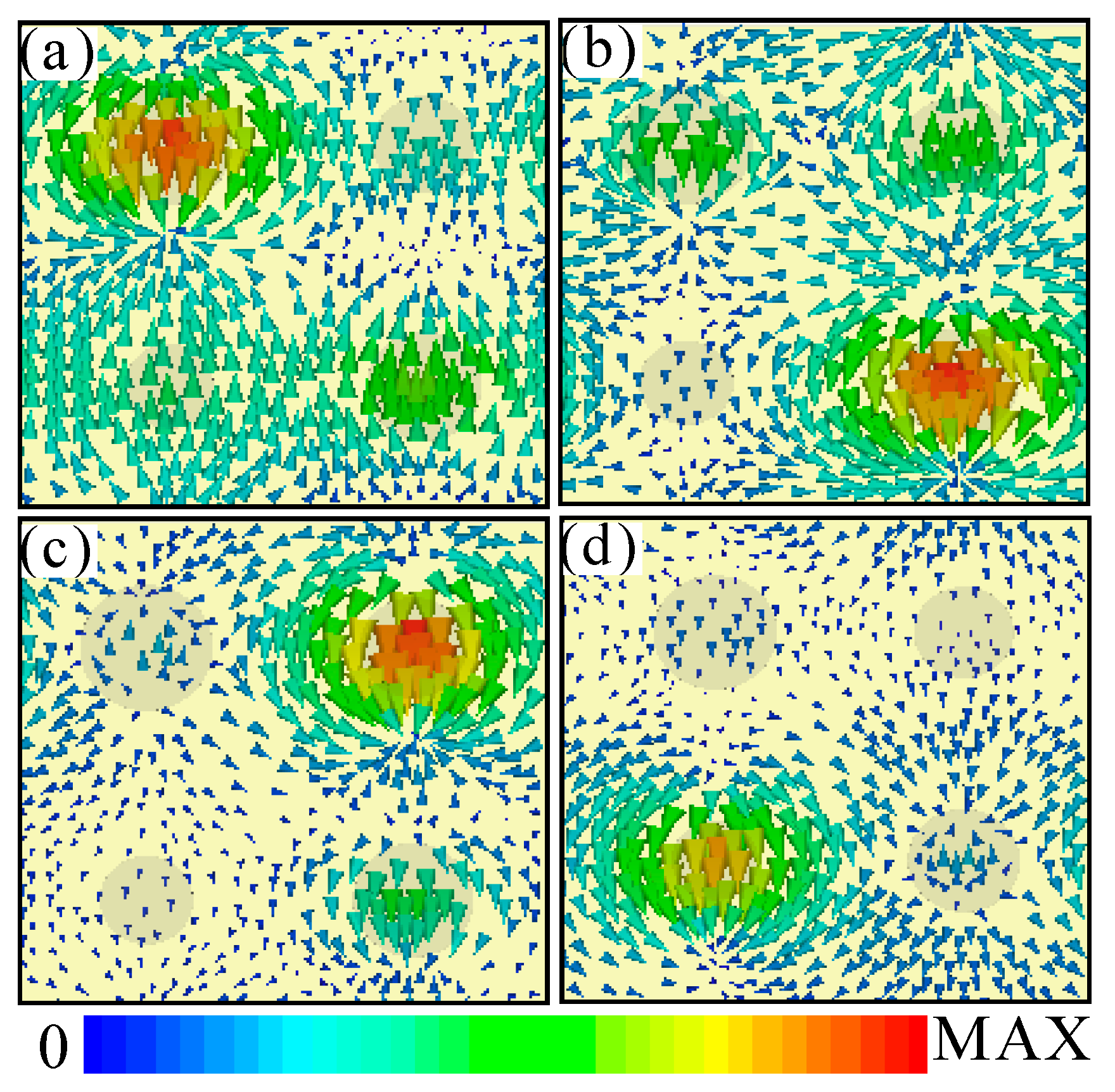Quad-Band Plasmonic Perfect Absorber for Visible Light with a Patchwork of Silicon Nanorod Resonators
Abstract
1. Introduction
2. Structure Design and Simulation
3. Results and Discussions
3.1. Narrowband PPA with Dependence of Silicon Nanostructure Geometric Dimension
3.2. Quad-Band PPA
4. Conclusions
Author Contributions
Funding
Conflicts of Interest
References
- Hao, J.J.; Wang, X.; Liu, W.; Padilla, J.; Zhou, L.; Qiu, M. High performance optical absorber based on a plasmonic metamaterial. Appl. Phys. Lett. 2010, 96, 251104. [Google Scholar] [CrossRef]
- Liu, X.L.; Starr, T.; Starr, A.F.; Padilla, W.J. Infrared spatial and frequency selective metamaterial with near-unity absorbance. Phys. Rev. Lett. 2010, 104, 207403. [Google Scholar] [CrossRef] [PubMed]
- Liu, N.; Mesch, M.; Weiss, T.; Hentschel, M.; Giessen, H. Infrared perfect absorber and its application as plasmonic sensor. Nano Lett. 2010, 10, 2342–2348. [Google Scholar] [CrossRef] [PubMed]
- Pu, M.; Hu, C.; Wang, M.; Huang, C.; Zhao, Z.; Wang, C.; Feng, Q.; Luo, X. Design principles for infrared wide-angle perfect absorber based on plasmonic structure. Opt. Express 2011, 19, 17413. [Google Scholar] [CrossRef] [PubMed]
- Kraemer, D.; Poudel, B.; Feng, H.P.; Caylor, J.C.; Yu, B.; Yan, X.; Ma, Y.; Wang, X.; Wang, D.; Muto, A.; et al. High-performance flat-panel solar thermoelectric generators with high thermal concentration. Nat. Mater. 2011, 10, 532–538. [Google Scholar] [CrossRef] [PubMed]
- Linic, S.; Christopher, P.; Ingram, D.B. Plasmonic-metal nanostructures for effient conversion of solar to chemical energy. Nat. Mater. 2011, 10, 911–921. [Google Scholar] [CrossRef] [PubMed]
- Watts, C.M.; Liu, X.; Padilla, W.J. Metamaterial electromagnetic wave absorbers. Adv. Mater. 2012, 24, 98–120. [Google Scholar] [CrossRef] [PubMed]
- Liang, Q.; Wang, T.; Lu, Z.; Sun, Q.; Fu, Y.; Yu, W. Metamaterial-based two dimensional plasmonic subwavelength structures offer the broadest waveband light harvesting. Adv. Opt. Mater. 2013, 1, 43–49. [Google Scholar] [CrossRef]
- Cui, Y.; Fung, K.H.; Xu, J.; Ma, H.; Jin, Y.; He, S.; Fang, N.X. Ultrabroadband light absorption by a sawtooth anisotropic metamaterial slab. Nano Lett. 2012, 12, 1443–1447. [Google Scholar] [CrossRef] [PubMed]
- He, Y.; Deng, H.; Jiao, X.; He, S.; Gao, J.; Yang, X. Infrared perfect absorber based on nanowire metamaterial cavities. Opt. Lett. 2013, 38, 1179–1181. [Google Scholar] [CrossRef] [PubMed]
- Mo, L.; Yang, L.; Nadzeyka, A.; Bauerdick, S.; He, S. Enhanced broadband absorption in gold by plasmonic tapered coaxial holes. Opt. Express 2014, 22, 32233–32244. [Google Scholar] [CrossRef] [PubMed]
- Yin, X.; Chen, L.; Li, X. Ultra-broadband super light absorber based on multi-sized tapered hyperbolic metamaterial waveguide arrays. J. Lightwave Technol. 2015, 33, 3704–3710. [Google Scholar] [CrossRef]
- He, S.; Ding, F.; Mo, L.; Bao, F. Light absorber with an ultra-broad flat band based on multi-sized slow-wave hyperbolic metamaterial thin-films. Prog. Electromagn. Res. 2014, 147, 69–79. [Google Scholar] [CrossRef]
- He, X.; Yan, S.; Lu, G.; Zhang, Q.; Wu, F.; Jiang, J. Ultra-broadband polarization-Independent perfect absorber for solar spectrum. RSC Adv. 2015, 5, 61955. [Google Scholar] [CrossRef]
- Tian, X.M.; Li, Z.Y. Visible-near infrared ultra-broadband polarization- independent metamaterial perfect absorber involving phase-change materials. Photonics Res. 2016, 4, 146. [Google Scholar] [CrossRef]
- Luo, H.; Cheng, Y.Z. Design of an ultrabroadband visible metamaterial absorber based on three-dimensional metallic nanostructures. Mod. Phys. Lett. B 2017, 31, 1750231. [Google Scholar] [CrossRef]
- Liu, P.; Lan, T. Wide-angle, polarization-insensitive, and broadband metamaterial absorber based on multilayered metal–dielectric structures. Appl. Opt. 2017, 56, 4201–4205. [Google Scholar] [CrossRef] [PubMed]
- Liu, Z.; Liu, G.; Huang, S.; Liu, X.; Pan, P.; Wang, Y.; Gu, G. Multispectral spatial and frequency selective sensing with ultra-compact cross-shaped antenna plasmonic crystals. Sensor Actuator B 2015, 215, 480–488. [Google Scholar] [CrossRef]
- Cheng, Y.Z.; Mao, X.S.; Wu, C.J.; Wu, L.; Gong, R.Z. Infrared non-planar plasmonic perfect absorber for enhanced sensitive refractive index sensing. Opt. Mater. 2016, 53, 195–200. [Google Scholar] [CrossRef]
- Yong, Z.; Zhang, S.; Gong, C.; He, S. Narrow band perfect absorber for maximum localized magnetic and electric field enhancement and sensing applications. Sci. Rep. 2016, 6, 24063. [Google Scholar] [CrossRef] [PubMed]
- Cui, W.; Liang, Y.; Wang, Q.; Liu, Y.; Li, L.; Lu, M.; Zhang, Z.; Masson, J.F.; Peng, W. Dual-channel narrowband polarization absorber with high field enhancement and refractive index sensitivity based on a nanorod array. J. Opt. Soc. Am. B 2018, 35, 237. [Google Scholar] [CrossRef]
- Cheng, Y.; Zhang, H.; Mao, X.S.; Gong, R.Z. Dual-band plasmonic perfect absorber based on all-metal nanostructure for refractive index sensing application. Mater. Lett. 2018, 219, 123–126. [Google Scholar] [CrossRef]
- Peng, Y.; Jiang, W.; Eric, A.; Alexander, G.; Wang, Z. Dual-band absorber for multispectral plasmon-enhanced infrared photodetection. J. Phys. D Appl. Phys. 2016, 49, 365101. [Google Scholar]
- Luo, M.; Shen, S.; Zhou, L.; Wu, S.; Zhou, Y.; Chen, L. Broadband, wide-angle, and polarization-independent metamaterial absorber for the visible regime. Opt. Express 2017, 25, 16715–16724. [Google Scholar] [CrossRef] [PubMed]
- Gong, Y.; Wang, Z.; Li, K.; Uggalla, L.; Huang, J.; Copner, N.; Zhou, Y.; Qiao, D.; Zhu, J. Highly efficient and broadband mid-infrared metamaterial thermal emitter for optical gas sensing. Opt. Lett. 2017, 42, 4537–4540. [Google Scholar] [CrossRef] [PubMed]
- Wu, J. Polarization-independent broadband absorber based on pyramidal metal–dielectric grating structure. Opt. Mater. 2016, 62, 47–51. [Google Scholar] [CrossRef]
- Xu, J.; Zhao, Z.; Yu, H.; Yang, L.; Gou, P.; Cao, J.; Zou, Y.; Qian, J.; Shi, T.; Ren, Q.; et al. Design of triple-band metamaterial absorbers with refractive index sensitivity at infrared frequencies. Opt. Express 2016, 24, 25742–25751. [Google Scholar] [CrossRef] [PubMed]
- Liu, G.; Yu, M.; Liu, Z.; Pan, P.; Liu, X.; Huang, S.; Wang, Y. Multiband high refractive index susceptibility of plasmonic structures with network-type metasurface. Plasmonics 2016, 11, 677–682. [Google Scholar] [CrossRef]
- Pillai, S.; Catchpole, K.; Trupke, T.; Green, M. Surface plasmon enhanced silicon solar cells. J. Appl. Phys. 2007, 101, 093105. [Google Scholar] [CrossRef]
- Agnese, R.; Ahmed, Z.; Anderson, A.; Arrenberg, S.; Balakishiyeva, D.; Thakur, R.B.; Bauer, D.; Borgland, A.; Brandt, D.; Brink, P. Silicon detector results from the first five-tower run of CDMS II. Phys. Rev. D 2013, 88, 031104. [Google Scholar] [CrossRef]
- Yang, S.; Richter, K.; Fischer, W. Multicolor generation using silicon nanodisk absorber. Appl. Phys. Lett. 2015, 106, 081112. [Google Scholar] [CrossRef]
- Vashistha, V.; Vaidya, G.; Hegde, R.S.; Serebryannikov, A.E.; Bonod, N.; Krawczyk, M. All dielectric metasurfaces based on cross-shaped resonators for color pixels with extended gamut. ACS Photonics 2017, 4, 1076–1082. [Google Scholar] [CrossRef]
- Kuyken, B.; Ideguchi, T.; Holzner, S.; Yan, M.; Hänsch, T.W.; Van Campenhout, J.; Verheyen, P.; Coen, S.; Leo, F.; Baets, R. An octave-spanning mid-infrared frequency comb generated in a silicon nanophotonic wire waveguide. Nat. Commun. 2014, 6, 6310. [Google Scholar] [CrossRef] [PubMed]
- Gorgulu, K.; Gok, A.; Yilmaz, M.; Topalli, K.; Bıyıklı, N.; Okyay, A.K. All-silicon ultra-broadband infrared light absorbers. Sci. Rep. 2016, 6, 38589. [Google Scholar] [CrossRef] [PubMed]
- Liu, G.; Nie, Y.; Fu, G.; Liu, X.; Liu, Y.; Tang, L.; Liu, Z. Semiconductor meta-surface based perfect light absorber. Nanotechnology 2017, 28, 165202. [Google Scholar] [CrossRef] [PubMed]
- Guo, Y.; Li, J.; Hou, X.; Lv, X.; Liang, H.; Zhou, J. A simple topology metamaterial blackbody for visible light. J. Alloy Compd. 2017, 699, 998–1002. [Google Scholar] [CrossRef]
- Yang, C.Y.; Yang, J.H.; Yang, Z.Y.; Zhou, Z.X.; Sun, M.G.; Babicheva, V.E.; Chen, K.P. Nonradiating silicon nanoantenna metasurfaces as narrow-band absorbers. ACS Photonics 2018, 5, 2596–2601. [Google Scholar] [CrossRef]
- Smith, D.Y.; Shiles, E.; Inokuti, M.; Palik, E.D. Handbook of Optical Constants of Solids, 1st ed.; Academic Press: Cambridge, MA, USA, 1985; pp. 369–406. [Google Scholar]
- Ordal, M.A.; Long, L.L.; Bell, R.J.; Bell, S.E.; Bell, R.R.; Alexander, R.W.; Ward, C.A. Optical properties of the metals Al, Co, Cu, Au, Fe, Pb, Ni, Pd, Pt, Ag, Ti, and W in the infrared and far infrared. Appl. Opt. 1983, 22, 1099–1120. [Google Scholar] [CrossRef] [PubMed]
- Cheng, Y.Z.; Fang, C.; Mao, X.S.; Gong, R.Z.; Wu, L. Design of an Ultrabroadband and High-efficiency reflective linear polarization convertor at optical frequency. IEEE Photonics J. 2016, 8, 1–9. [Google Scholar] [CrossRef]
- Cheng, Y.Z.; Chen, H.; Zhao, J.C.; Mao, X.S.; Cheng, R.Z. Chiral metamaterial absorber with high selectivity for terahertz circular polarization waves. Opt. Mater. Express 2018, 8, 3104–3114. [Google Scholar] [CrossRef]
- Cheng, Y.Z.; Zou, H.; Yang, J.J.; Mao, X.S.; Gong, R.Z. Dual and broadband terahertz metamaterial absorber based on a compact resonator structure. Opt. Mater. Express 2018, 8, 1399–1409. [Google Scholar] [CrossRef]
- Engheta, N. Circuits with Light at Nanoscales: Optical Nanocircuits Inspired by Metamaterials. Science 2007, 317, 1698–1702. [Google Scholar] [CrossRef] [PubMed]
- Wang, L.P.; Zhang, Z.M. Resonance transmission or absorption in deep gratings explained by magnetic polaritons. Appl. Phys. Lett. 2009, 95, 111904. [Google Scholar] [CrossRef]
- Park, C.S.; Shrestha, V.R.; Yue, W.; Gao, S.; Lee, S.S.; Kim, E.S.; Choi, D.Y. Structural color filters enabled by a dielectric metasurface incorporating hydrogenated amorphous silicon nanodisks. Sci. Rep. 2017, 7, 2556. [Google Scholar] [CrossRef] [PubMed]






© 2018 by the authors. Licensee MDPI, Basel, Switzerland. This article is an open access article distributed under the terms and conditions of the Creative Commons Attribution (CC BY) license (http://creativecommons.org/licenses/by/4.0/).
Share and Cite
Cao, C.; Cheng, Y. Quad-Band Plasmonic Perfect Absorber for Visible Light with a Patchwork of Silicon Nanorod Resonators. Materials 2018, 11, 1954. https://doi.org/10.3390/ma11101954
Cao C, Cheng Y. Quad-Band Plasmonic Perfect Absorber for Visible Light with a Patchwork of Silicon Nanorod Resonators. Materials. 2018; 11(10):1954. https://doi.org/10.3390/ma11101954
Chicago/Turabian StyleCao, Can, and Yongzhi Cheng. 2018. "Quad-Band Plasmonic Perfect Absorber for Visible Light with a Patchwork of Silicon Nanorod Resonators" Materials 11, no. 10: 1954. https://doi.org/10.3390/ma11101954
APA StyleCao, C., & Cheng, Y. (2018). Quad-Band Plasmonic Perfect Absorber for Visible Light with a Patchwork of Silicon Nanorod Resonators. Materials, 11(10), 1954. https://doi.org/10.3390/ma11101954




